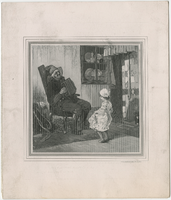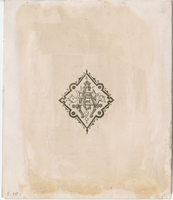Search the Special Collections and Archives Portal
Search Results
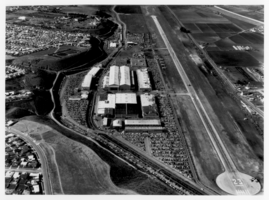
Aerial photograph of Hughes Airport, Culver City, California, circa early 1960s
Date
1960 to 1965
Archival Collection
Description
Aerial view of the airport at Hughes' aircraft plant in Culver City, California. The airport's runway was in operation from 1941 to 1985.
Image
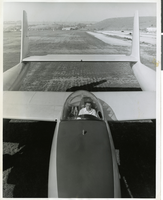
Photograph of Howard Hughes sitting in the cockpit of the XF-11 preparing for his first test flight in Culver City, California July 7, 1947
Date
1947
Archival Collection
Description
Transcribed from press release attached to back of photo: "NEW PHOTO PLANE TEST-FLOWN CULVER CITY, California, July 7 -- Howard Hughes, who designed and built the new FX-11 reconnaissance plane in conjunction with Air Materiel Command engineers, sits in the pilot's bubble-glass canopy preparing for the first test flight. One of the world's fastest long-range photo planes, the XF-11 can attain a speed of more than 400 miles per hour, Army officials said. It is powered by two 3000-horsepower radial engines with eight-bladed contra-rotating propellers. Outstanding features include a full-span flap, unique eight-camera layout, and exceptionally fast take-off." Transcribed from photo sleeve: "Howard Hughes sits in the cockpit of the XF-11, a reconnaissance plane that Hughes built and designed in conjunction with Air Materiel Command engineers. Hughes is preparing for his first test flight in Culver City, California July 7, 1947.
Image
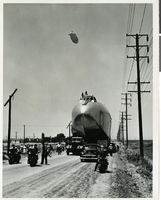
Photograph of the fuselage section of the Hughes Flying Boat being moved to Terminal Island, California, 1946
Date
1946
Archival Collection
Description
A section of Howard Hughes' "Spruce Goose" or "Flying Boat" being moved (with a police escort) from the Hughes Aircraft plant in Culver City, California to Terminal Island in the Los Angeles Harbor where the plane was assembled in June of 1946.
Image

New Harper Hotel Easter menu, 1910
Date
1905-03-24
Archival Collection
Description
Note: Lavender ribbon. Violet flowers painted on cover. Includes music program Menu insert: Music Programs Restaurant: New Harper Hotel Location: Rock Island, Illinois, United States
Text
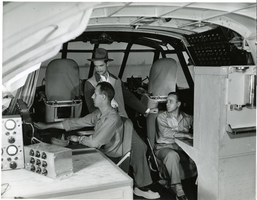
Photograph of Howard Hughes and Dave Evans on the Flying Boat, Los Angeles Harbor, November 1, 1947
Date
1947-11-01
Archival Collection
Description
Howard Hughes with his flight engineer and Dave Evans, radio operator, preparing for the Flying Boat's taxi test the next day. The group is shown on the flight deck of the 24,000 horsepower craft. The Flying Boat was assembled on Terminal Island in the Los Angeles Harbor.
Image
New artist auditions schedule, 1978
Level of Description
File
Archival Collection
Young Audiences New York, Nevada Humanities Collection
To request this item in person:
Collection Number: MS-00227
Collection Name: Young Audiences New York, Nevada Humanities Collection
Box/Folder: Box 05
Collection Name: Young Audiences New York, Nevada Humanities Collection
Box/Folder: Box 05
Archival Component
GM-Hughes Electronics first shares of stock distributed, 1987
Level of Description
File
Archival Collection
Hughes Electronics Corporation Records
To request this item in person:
Collection Number: MS-00485
Collection Name: Hughes Electronics Corporation Records
Box/Folder: N/A
Collection Name: Hughes Electronics Corporation Records
Box/Folder: N/A
Archival Component
Pagination
Refine my results
Content Type
Creator or Contributor
Subject
Archival Collection
Digital Project
Resource Type
Year
Material Type
Place
Language
Records Classification

